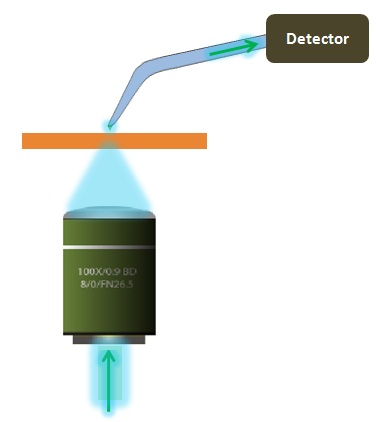Cantilevered probes for the best NSOM performance
Nanonics is the global pioneer in glass probe manufacturing and has developed a whole suite of probes for all your NSOM applications for both apertured and apertureless NSOM, fiber probes with metallic nanoparticles embedded in the tip, metallized probes for STM, and straight probes for shear force feedback.
All modes of NSOM
True reflection mode NSOM
True Reflection mode NSOM is possible due to the use of transparent, cantilever probes. Furthermore, our design separates the excitation and collection paths so that they don't affect each other, thus enabling true reflection mode NSOM measurements to be conducted. Other designs that take advantage of straight probes or apertured Si probes are significantly more challenging for true reflection mode.
Transmission mode NSOM
Transmission mode NSOM is suitable for transparent or semi-transparent samples where light is introduced through the optical fiber and collected by a detector underneath the sample.
True Collection Mode
True collection mode enabled by systems with both tip scanning and a sample scanning stage. A sample scanning stage enables easy and rapid alignment of the sample relative to the illumination source and ensures that the microscope optics are independent of the AFM scanner.
Multiple probe capability
Near-field excitation and collection are possible with instrumentation accomodating up to 4 independent probes for simulatneous operation. Each probe can be configured in apertured or apertureless configurations for applications like plasmon injection, dark plasmons studies, and generation and distribution of SPPs and other photonic waveguides.
Any optical configuration
This enables total flexibility in your NSOM setup by integration with any optical microscope. Additionally, total optical access to sample and probe position from above is possible since the cantilever probe/scanner assembly does not obscure access.
Largest commercially available Z range
The large, 85 μm X, Y and Z-range of the Nanonics 3D FlatscanTM makes it ideal for optical sectioning in confocal imaging. Used in this way, you can integrate conventional far-field imaging, confocal microscopy, AFM, and near-field optics in a single system

